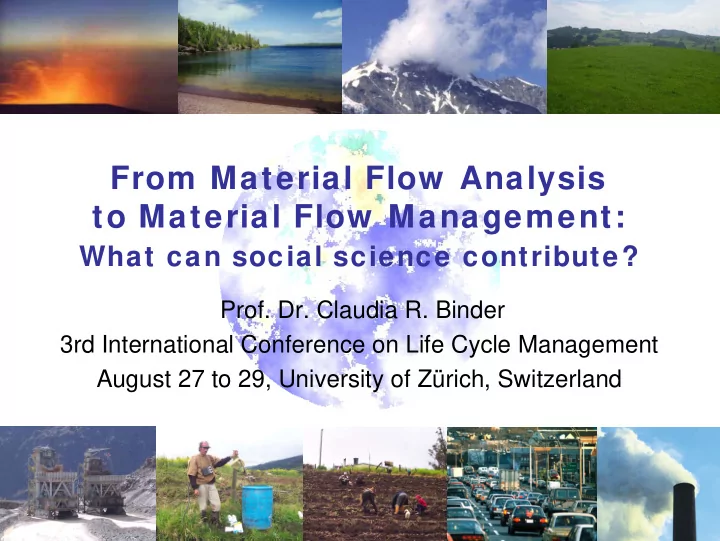

From Material Flow Analysis to Material Flow Management: What can social science contribute? Prof. Dr. Claudia R. Binder 3rd International Conference on Life Cycle Management August 27 to 29, University of Zürich, Switzerland C.R. Binder 3rd International Conference on Life Cycle Management, August 27-29, 2007
The issue • MFA-Analyses provide a broad understanding of the material system (static, dynamic, etc.) ⇒ Costs / LCC • Enterprise / firm level ⇒ Multistakeholder & - goals • Regional level ⇒ Driving variables, trends • National level C.R. Binder 3rd International Conference on Life Cycle Management, August 27-29, 2007
Research question How can social science approaches contribute to a better implementation of results from material flow analysis at a regional level? C.R. Binder 3rd International Conference on Life Cycle Management, August 27-29, 2007
Interaction betw een social structure, individuals & environment Social structure Environment Rules (Material • Signification (status) • Legitimation (norms) consequences) Resources • Authoritative (power) • Allocative (capital) Individual After Binder, 2007 C.R. Binder 3rd International Conference on Life Cycle Management, August 27-29, 2007
Social Struture Signification Legitimation Meaning and interpretation Explicit and implicit moral rules • Traditions • Legislation • Culture • Cultural norms • Status, etc. • Group norms Authoritative R. Allocative R. Non-material resources • Material resources involved in the involved in the generation of generation of power power • Capital • Religion • Market influence • Social capital / networks • etc. • etc. After Giddens 1994 and Binder, 2007 C.R. Binder 3rd International Conference on Life Cycle Management, August 27-29, 2007
Social structure and disciplines Social structure Discipline Signification Psychology Sociology Rules Legitimation Law Psychology (groups) Sociology Authoritative Sociology Psychology Resources Economy Allocative Economy C.R. Binder 3rd International Conference on Life Cycle Management, August 27-29, 2007
Approaches from Economy (I) Modeling Purpose Advantages Disadvantages approach • Economic system • Quantitative • Depends on Input/Output ⇒ environment models model country statistics • Simulation • No dynamic • Assessment of (cash flows) model analysis changes in eco- nomic structure Examples : Hybrid Waste I/O: Nakamura this session Paper value added chain: Nathani, 2003 Food value added chain: Faist, 2003; Kytzia et al. 2004 Source: Binder, 2007 C.R. Binder 3rd International Conference on Life Cycle Management, August 27-29, 2007
Approaches from Economy (II) Modeling Purpose Advantages Disadvantages approach • Variables affecting • Quantitative • Variables e.g., Micro- economic behavior (incl. simulation norms, culture models environmental variables) models difficult to include • Policy input • Effect of policies • Often snapshot on behavior Examples : Drivers for copper flows: Binder et al., 2005 Driving factors for land use change: Costanza et al., 1996 Farmers management behavior: Abdulai and Binder, 2005 Effect of market based climate change policies on capital intensive industries: Ruth et al., 2002 Source: Binder, 2007 C.R. Binder 3rd International Conference on Life Cycle Management, August 27-29, 2007
Integrative approaches • Analyze the relationship among social structure (including additional aspects of social system, i.e. culture, social norms), individual decisions and material consequences • Allow for determining restrictions and facilitators for action • Support investigation of transition processes with heterogeneous stakeholders groups C.R. Binder 3rd International Conference on Life Cycle Management, August 27-29, 2007
Integrative approaches Modeling Purpose Advantages Disadvantages approach • Coupled human- • Multistakeholder • Qualitative or Integrative approaches env. models and -goal only binary model • Social structure analysis • Region and • Time and scale constraints on env. culture specific action differences • Structural changes • Relative easy to necessary for link with MFA change Examples : Quantification of Luhman’s theory (binary model): Grant et al., 2002 Structural Agent Analysis: Binder, 2007 Source: Binder, 2007 C.R. Binder 3rd International Conference on Life Cycle Management, August 27-29, 2007
Regional w ood flow (AR, 2002) 220 CO 2 4.4 1.9 7.4 6.8 6.4 17.4 9.4 Forest Sawmill Wood processing ecosystem industry industry 0 + 0 3,550 + 42 0 + 0 3.9 2.3 2.5 3.4 6.4 Household 1 consumption Forest owner Energy consumption production 550 + 5 0 + 2 0 + 0 Systemborder: AR 1.4 CO 2 5.8 11 CO 2 6.4 15.8 24.6 Source: Binder et al, 2004 C.R. Binder 3rd International Conference on Life Cycle Management, August 27-29, 2007
Agent or Characteristics Timeframe Goals Structure of agent group Planning Needs regulation horizon Forest 75% private 50-100 Comply with law Legislation owners years Size: 1 ha No deficit Organizational structure Market Sawmills & Family to 1-5 years Economic Market medium benefit Wood Organizational enterprises processing structure industries Consumers Individuals 1-10 years Semi-assembled Lifestyle & goods Enterprises Market Construction Wood quality industries Cantonal 10-20 Sustainable International and federal years forest and wood treaties government management
Conclusions • To improve the implementation of MFA-results at a regional or higher level it is necessary to link MFA with social science approaches • The link with economic models can provide a good understanding of one aspect driving human decisions : Focus: allocative resources • Integrative approaches are required to understand: – Options and restriction of social structures – Time and scale dimensions – Conflicts among involved stakeholders C.R. Binder 3rd International Conference on Life Cycle Management, August 27-29, 2007
Thank you for your attention! For more information: Prof. Dr. Claudia R. Binder Social and Industrial Ecology Dept. of Geography University of Zurich, Switzerland claudia.binder@geo.uzh.ch C.R. Binder 3rd International Conference on Life Cycle Management, August 27-29, 2007
Recommend
More recommend